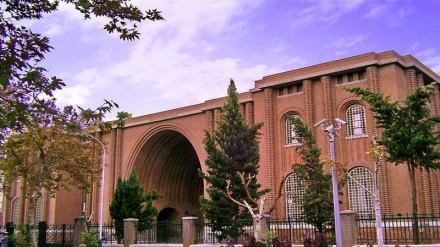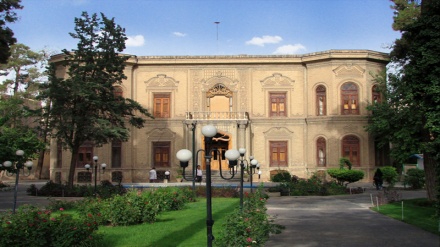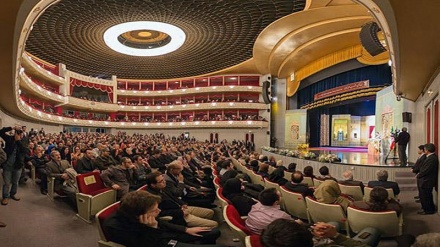Iran Your Attractive Destination (201)
Today, we become familiar with the Holy Shrine of the Founder of Islamic Republic of Iran, late Imam Khomeini (May his soul rest in peace).
Now, we introduce one of the most crowded sites of pilgrimage in Tehran Province, which is visited by countless people, from the important global political figures to ordinary people, even from the remotest villages of Iran. In this site of pilgrimage, a man has been laid to rest, whose elevated leadership and thoughts led to a major development in the World of Islam in the recent century, while changing the political equations, worldwide.
We are speaking of the Father of Islamic Revolution, late Imam Khomeini (May his soul rest in peace).
Imam Khomeini Holy Shrine is located eight kilometers south of Tehran, and at a twenty-five kilometer distance from Imam Khomeini International Airport, adjacent to the tombs of martyrs of Iran’s Islamic Revolution . This region maintains a distinct geographical position, due to linkage of northern, southern, western, and eastern parts of Iran. The complex of Imam Khomeini Holy Shrine consists of the main holy shrine and its surrounding courtyards. This complex will be a section of a larger complex under the heading of “Shahr-e Aftab”, which means the City of the Sunlight in Farsi language. “Shahr-e Aftab” will be an academic, cultural, touristic, and commercial city, which will cover an area of over 10200 hectares.
The Holy Shrine Complex covers an area of 600,000 square meters, including the main building, the parking lot, open space, and engine rooms. The surrounding courtyards of the Holy Shrine are beautifully decorated with flowers and trees and fountains. It is interesting to know that the Islamic architectural style of Imam Khomeini Holy Shrine has led to creation of a pilgrimage site which captures the attention of all pilgrims.
The foundation of Imam Khomeini Holy Shrine stands at 16000 square meters.
The interior of the Holy Shrine is divided into nine equal sections, while the middle square is the location of the sepulcher and the main dome of this Holy Shrine. At the center of the Holy Shrine, the sepulcher and tomb of late Imam Khomeini (May his soul rest in peace), and his late son, Hojjatoleslam Haaj Ahmad Aqa, is situated. It is noteworthy that adjacent to the sepulcher, the tombs of Imam’s late spouse, Khadija Saqafi, in addition to Ayatollah Soltani Tabatabai, and Ayatollah Sheikh Mohammad Reza Tavasoli, are located.
The old sepulcher of late Imam’s Holy Shrine is eight meters to ten meters in dimensions, and a height of five meters, and is made of aluminum. The new sepulcher is similar to the sepulchers of other sites of pilgrimage in Iran. This sepulcher is made of steel. The interior design and its decorations are astounding, and a blend of best original Islamic and modern arts. Note that the ceiling of this Holy Shrine rests on four pillars, which are of significant importance in relation to their architecture, granting a unique grandeur to this Holy Shrine.
The main dome of this Holy Shrine is comprised of three different heights. The first height stands at 42 meters which is a reminder of the year 1342 in Iran’s solar calendar, corresponding to the year 1963 AD, which marks the start of open campaign of late Imam Khomeini (May his soul rest in peace) against the former Pahlavi despotic regime.
The next height of this dome stands at 57 meters, which is the reminder of the year 1357 in Iran’s solar calendar, corresponding to 1979 AD, marking the year of victory of Iran’s Islamic Revolution.
The last height of the dome stands at 68 meters, which is the reminder of the year 1368 in Iran’s solar calendar, corresponding to 1989 AD, marking the year of demise of the Founder of Islamic Republic of Iran, late Imam Khomeini (May his soul rest in peace).
Imam Khomeini Holy Shrine hosts countless pilgrims every day. For the comfort of pilgrims, four courtyards have been constructed around the main night prayer hall.
The courtyards maintain different functions. They have been covered with stones, which are decorated with writings and ayahs of Holy Quran.
The dome which is the biggest symbol and a sign of innovation in this Holy Shrine, approximately weighs 400 tons, resting on four pillars. The main dome of the Holy Shrine is located above the sepulcher, in addition to four other turquoise domes situated next to gateways of the courtyards. In this manner, this Holy Shrine maintains a total of five domes.
The main dome and minarets are made of metals, while the main dome is golden in color and can be spotted from a far distance. Upon the nightfall, the golden dome maintains an astounding beauty.
Overall, the architecture of Imam Khomeini Holy Shrine is a blend of Iranian religious and traditional architectural style and modern architecture. The structure of the building is made of concrete. Given that Iran is a quake-prone country, the cities of Iran and Rayy are no exception to this fact. Hence, in the design and construction of Imam Khomeini Holy Shrine, highly resistant concrete structures have been used which resist quakes up to the magnitude of ten in the Richter scale. This is certainly one of the important characteristic features of this Holy Shrine, alongside its magnificent Islamic-Iranian architectural style.
The facades of the Holy Shrine Complex are made of stones. Different kinds of stones in white, pale pink, red, yellow, gray, black, and green colors have been cut by stonecutters, under the supervision of seasoned Iranian engineers and designers, thereby manifesting a plethora of arts and decorations on stones.
For the comfort of pilgrims, who pay a visit to Imam Khomeini Holy Shrine, a number of services have been taken into consideration, which includes restrooms, bathrooms, the central kitchen, dining halls, and health centers, covering a total area of roughly 150,000 square meters. Residential units have also been constructed in northwestern and northeastern parts of this Holy Shrine for the residence of pilgrims.
Moreover, Imam Khomeini Holy Shrine is home to a library, film and slide centers, late Imam and Islamic Revolution Museum, security sections, and administrative and commercial sections.
MR/ME


